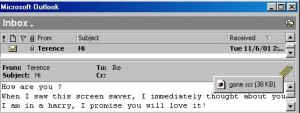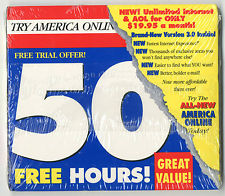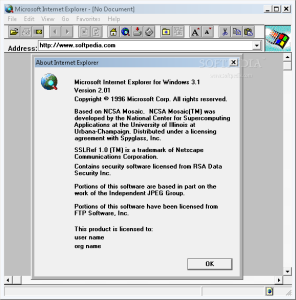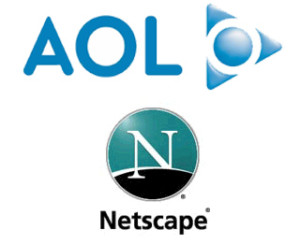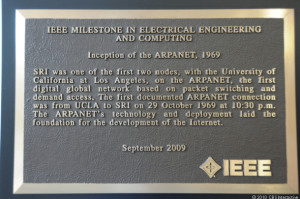The Internet
RIAA Sues Napster
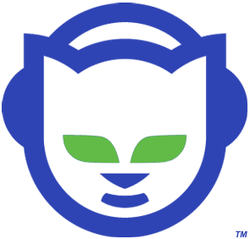
The Recording Industry Association of America sues the peer-to-peer file sharing service Napster alleging copyright infringement for allowing users to download copyrighted music for free. The RIAA would eventually win injunctions against Napster forcing the service to suspend operations and eventually file bankruptcy. In the end the RIAA and its members would settle with Napster’s financial backers for hundreds of millions of dollars.
While the case was ostensibly about copyright violations, the bigger picture for the RIAA was also about control. The recording industry in general was caught with its pants down when it came to digital music and the Internet. They were not prepared for the sudden popularity of digital music downloads that Napster introduced and were not ready with a model to monetize downloaded music. This lawsuit, along with future lawsuits targeting individuals, was intended to squash the practice of downloading music as much as it was to recover compensation. However, the practice of downloading music could not be stopped as other non-centralized peer-to-peer file sharing services popped up in place of Napster. Faced with the ever increasing tide of users downloading music for free, eventually the recording industry reluctantly got on board with commercialized music downloading services like the iTunes Music Store. However they still lost a great deal of control over the marketplace. Leveraging the huge success of iTunes, Apple enforced a strict pricing policy much to the consternation of the record companies. By creating a de-facto pricing standard for downloaded music, Apple became the major powerhouse in the music industry. The runaway success of iTunes also had the effect of Apple displacing established retail and radio outlets as the gatekeepers of popular music. As well, the ability for artists independent of record companies to distribute their music and gain followings greatly disrupted the control the RIAA and its members had over the music industry. While the RIAA may have taken down Napster, what Napster started completely changed the direction of both the music and technology industries.
Initial ARPANet Completed
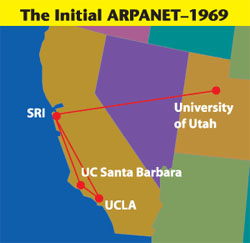
The University of Utah becomes the fourth node on the ARPANet*. This completed the planned original nodes on the experimental network that would eventually evolve into what we now know as the Internet.
*Some sources claim this date as December 1st. I can not yet find a definitive source.
Goner Worm Hits Internet
Disguised as a screen saver and spread through an infected user’s Microsoft Outlook e-mail software, the Goner worm spreads through the Internet at a pace second only to the Love Bug virus the previous year. Goner was estimated to cause about $80 million dollars in damage.
Business.com is Big Business

The domain name business.com sells for $7.5 million. At the time, it was the most expensive domain name sold in history and still ranks in the top 15 all-time most expensive domain names. Domain name investor Marc Ostrofsky had purchased the domain in the mid 90’s for $150,000.
In 2007 the company that owned Business.com and created a ad network website around the domain sold for $345 million to Yellow Pages publisher R.H. Donnelly. Marc Ostrofsky reportedly owned a stake in this company as well.
If only I had the foresight in the 90’s to buy up simple domain names when they were all available! I was in the right position to do so, but I just didn’t think of doing it until years later when they had already been registered and started selling for crazy amounts of money. However, I did help my parents sell a domain they registered in the 90’s for $20,000. Looking back now, I probably could have gotten a lot more for it.
AOL Goes Unlimited
America Online launches a new subscription plan offering their subscribers unlimited dial-up Internet access for $19.95/month. Previously, AOL charged $9.95/month for 5 hours of usage. The new plan brought in over one million new customers to AOL within weeks and daily usage doubled among subscribers (to a whole 32 minutes per day!). This huge increase in usage overloads AOL’s infrastructure with the result being that many of their subscribers could not access the service. Class action lawsuits were filed by angry subscribers who could no longer access the service they were paying for. Regardless of their trouble, by offering unlimited Internet access for a reasonable fee, AOL helped facilitate increased adoption of Internet usage among a public still becoming acclimated to the “Information Superhighway”.
Project Gutenberg Launched
Michael Hart, founder of what is now known as Project Gutenberg, launches the project by making his first posting, the Declaration of Independence. Now known as the father of eBooks, earlier in the year Hart had been given an operator’s account on a mainframe at the University of Illinois, where he was a student. Having been given highly valuable computer time when few people had such opportunity, he decided to begin a project that would digitize and electronically preserve public domain books and texts and make them freely available. The Xerox Sigma V mainframe at the Materials Research Lab at the University of Illinois just happened to be one of the first 15 nodes on the early ARPANet, the beginning of the modern Internet. The ability to for anyone connected to this network to download information was a major inspiration for Hart to begin Project Gutenberg.
Microsoft Ships Internet Explorer 2.0
Nearly 6 months to the day after Bill Gates sent his Internet Tidal Wave memo recognizing the importance of the Internet, and only 3 months after releasing version 1.0, Microsoft releases Internet Explorer 2.0 for Windows 95 and Windows NT 3.5. IE 2.0 was still based on licensed code from Spyglass Mosaic, but was the first IE version to support now-common features such as SSL, JavaScript, and cookies. It was also the first version to allow the importing of bookmarks from Netscape Navigator, which at the time had a virtual monopoly on the web browser market. This was the first inklings of the “browser war” that was soon to erupt over the next few years.
Roxio Acquires Napster Legacy

Digital media software company Roxio purchases the assets of the former Napster, including name, logo, domain name, technology portfolio, and other intellectual property. Napster was the peer-to-peer file sharing service that changed the music industry forever, facilitating the easy sharing of music, much to the chagrin of the established music industry. The RIAA sued Napster causing a judgement against the file-sharing service requiring them to monitor its network for copyright infringing material and restrict access when made aware of such incidents. Napster could not comply with this court order and shut down its service before declaring bankruptcy in 2002.
Roxio was the first company to attempt to use the Napster brand for a music service, renaming Pressplay as Napster 2.0. In September 2008, Best Buy purchased the Napster service for $121 million, before merging it with the Rhapsody service in December 2011.
AOL Buys Netscape
AOL announces it will buy Netscape Communications in a stock-for-stock deal worth approximately $4.2 billion. At the time it was considered a move by AOL and Netscape to merge forces to better compete with Microsoft in the browser and Internet provider markets. However, Microsoft’s dominance in the personal computer market could not be stopped and the Netscape browser lost almost all marketshare to Internet Explorer. In 2003 Microsoft settled a monopoly lawsuit with AOL (then merged with Time Warner) for $750 million over the loss of value of Netscape. AOL itself, once a dominant Internet Service Provider, slowly lost their subscriber base with the evolution of broadband Internet in the 2000’s and operates primarily as a media conglomerate, although their dial-up service still subscribes approximately 2 million users as of 2013.
The Birth of the Internet
A little less than a month after the first test message was sent, the first permanent link on the ARPANet is established between UCLA and the Stanford Research Institute. As the ARPANet was the foundation of the modern Internet, this connection can now be considered the very first link of what we now know as the Internet.

